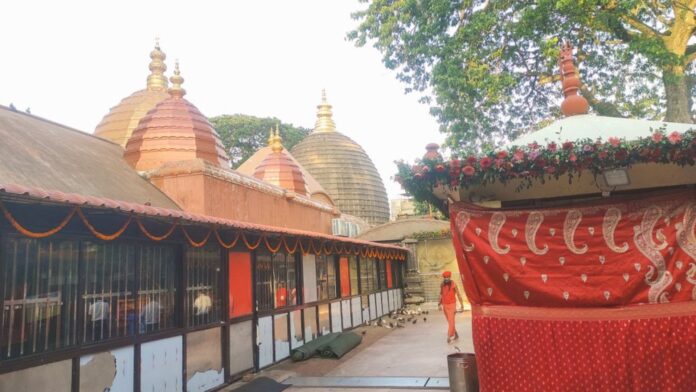The annual Ambubachi Mela at the historic Kamakhya Temple atop Nilachal Hills in Guwahati witnessed a massive influx of devotees, saints, and seekers from across India and abroad, as the temple observed the sacred period marking the menstrual cycle of Goddess Kamakhya, a powerful symbol of fertility and creation in Shakta tradition. A lot of people come to take blessings from the Goddess. “Today morning we climbed up to Kamakhya Temple and visited Ma Kamakhya Temple and took the blessing. I hope with the blessing of Maa Kamakhya, we will be able to stay in a safe and peaceful place,” said Dr Vivek Roy from Karbi Anglong, Assam who came along with his family.
Lakhs of pilgrims, along with thousands of sadhus, sanyasis, and tantriks, thronged the temple premises to seek blessings, meditate, and participate in age-old rituals believed to bestow spiritual liberation, inner peace, and tantric siddhis. The mela, often referred to as the “Mahakumbh of the East,” is considered one of the most spiritually significant gatherings in India.
Speaking to reporters, several devotees shared their experiences of climbing up to the temple at dawn, offering prayers, and meditating in the spiritually charged atmosphere. The sanctum sanctorum remains closed during the mela, symbolising the Goddess’s period of rest. Ironically, it is this closure that makes the moment even more sacred, with many believing it to be the best time for worship and penance.
The festival is especially revered by followers of tantric traditions, as Kamakhya is regarded as one of the ten Mahavidya Peethas and a powerful centre of tantra. “This is the centre of creation, where nature begins. No one can fully grasp the ‘Leela’ of the Divine Mother or the depth of her love,” a sadhu said during an interaction.
People in Guwahati have been excited to host the annual festival as it marks a tradition that has been going on since ages. Speaking to TDG, Guwahati resident Ripon Barua said, “It is a four-year festival and people from different parts of India come here, not just India, nowadays many foreigners also come, devotees also come and these four days of Ma Kamekha are considered to be the biggest Peeth in India for tantra siddhi, because Kamaksha has ten Peeths, so there are ten Peeths and these four days are very sacred and people come here to do Japa and Tapa and they get a lot of Siddhis. And as a result of that, we see people coming from different parts of the country, Sadhus and Sanyasis as well, coming here to worship and in this auspicious time, it is a very auspicious time to come here and worship.”
The temple complex has transformed into a vibrant spiritual hub with people engaged in deep meditation, chanting hymns, performing rituals, and seeking divine energies. Sadhus shared how this mela represents a moment of personal transformation and spiritual awakening. One saint narrated his own journey from despair to divine service, stating that surrendering to the spiritual path changed his life and brought him inner peace.
Yet, as spiritual leaders emphasised, salvation is not limited to renunciants. TDG interacted with the Naga Sadhus to find out about their journey to be a Sadhu. “So, a time came when I lost interest in life. I thought of dying. So, with the blessings of Guru Maharaj, he said, It is better to live as a sadhu than to die as a sadhu,’ said Apporvanand, a Sadhu meditating at the premises of the temple.
As the footfall continues to rise, authorities have tightened security and sanitation arrangements to accommodate the influx, ensuring safe and peaceful participation for all.
The Ambubachi Mela is an annual Hindu mela (gathering) held at Kamakhya Temple in Guwahati, Assam. This yearly mela is celebrated during the monsoon season that happens to fall during the Assamese month Ahaar, around the middle of June, when the sun transits to the zodiac of Mithuna, when the Brahmaputra River is in spate. During this time Brahmaputra River near the temple turns Red for three days.








